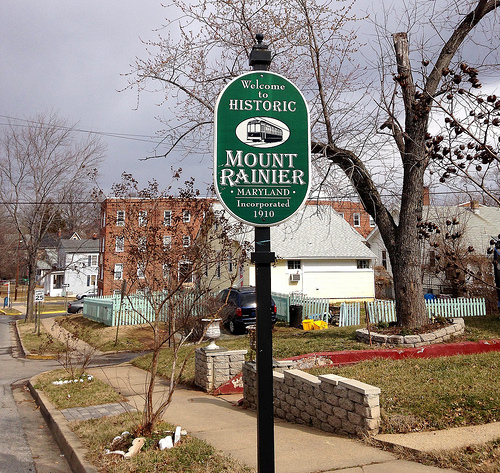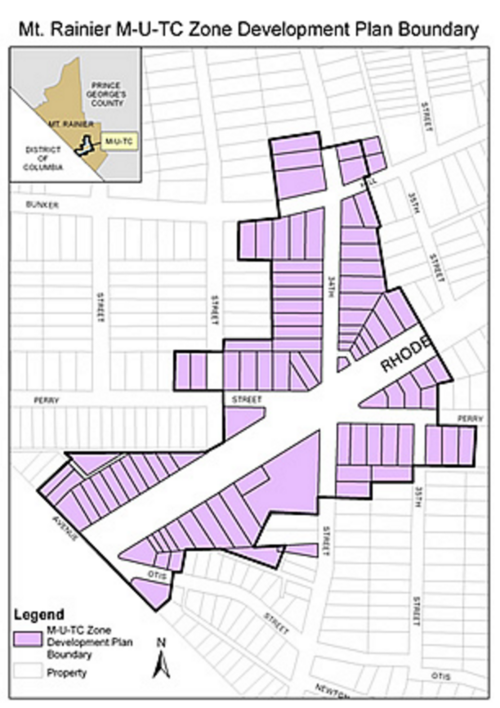Can a new zoning code make Mt. Rainier inviting and affordable?
Long considered up and coming, Mount Rainier is a Prince George’s neighborhood just east of the District line that’s attracting investors and where house prices are rising. Typically, more zoning means higher housing costs, but Mount Rainier residents are trying to use zoning to keep their neighborhood inclusive and affordable. Is that possible?
Mount Rainier’s MO: cheap and funky
Mount Rainier is a historic streetcar suburb bordering DC’s Ward 5 that has, for decades, been an affordable destination for renters and owners as well as a haven for interracial, gay, and immigrant families. It’s a diverse community, where multiculturalism is not an ideology, but a way of life.
A major part of the city’s charm is this neighborly community vibe, which in turn is created and encouraged by the city’s urban fabric: early 1900s vernacular architecture including porches near the sidewalks, front yard art installations, and other community-building features. Today, the motto of the local grocery co-op sums it up: “still cheap, still funky.”
Today, Mount Rainier is still mostly a cozy collection of small bungalows and Victorians. But home prices are spiraling up, making renovations a hot topic.
Mount Rainier has been here before: Prior to the bursting of the early 2000s real estate bubble, Mount Rainier saw a wave of ambitious home renovations that peppered cheap and/or architecturally deaf flips and McMansions amidst the subsequent foreclosure crisis.
Mount Rainier might change its zoning
In a process tracing back to the aforementioned era, the Mount Rainier community is considering a new zoning overlay to cover its single family homes. This Architectural Conservation Overlay Zone (ACOZ) has been proposed as a middle ground between a flipping free-for-all and a restrictive historic district.
The goal of the ACOZ is to encourage renovation and new home construction that is compatible with the existing built environment while preventing poorly executed projects.
As currently proposed, new code would impose detailed design standards and significantly expand the cases in which a building permit is required for residential home construction and renovations.
All homeowners would receive a “pattern book” with guidance and resources about maintaining Mount Rainier’s residential architectural fabric, and a local committee would review applications for any project that required a permit to ensure compliance with the standards.
This might sound scary to some, but this is actually exactly how the process works now: A volunteer design review board already reviews many house renovation permits in Mount Rainier, so there is ample precedent for this type of review. Considering that current county zoning requires the board to review permits for residential fences, fears of the ACOZ creating a significant new permitting hurdle may well be overstated.
This has worked in Mount Rainier before
Conventional wisdom says that land use controls like zoning increase the cost of construction and restrict supply, making housing less affordable. And while most would support the laudable goal of maintaining the much loved sleepy neighborhood look, there is always a concern for unintended consequences.
Luckily, this is not Mount Rainier’s first experiment with trying to invent a type of zone that both welcomes growth and incorporates the existing built environment.
In 1994 Prince George’s County created the first Mixed Use Town Center zone in Mount Rainier, the goal being to revitalize traditional storefronts and invigorate the commercial district. The award-winning 2010 update of this plan established a community vision for a revitalized downtown Mount Rainier as a walkable, green, lively neighborhood-oriented retail center.
As many communities nationwide chase major chains or tourism dollars, Mount Rainier has recommitted to the local, the independent, and the original, saving environmental and financial resources with adaptive reuse of our historic buildings. The MUTC plan incentivizes historic reuse by imposing far more stringent review requirements on new construction, and establishes design standards to promote compatible and quality development.
Redevelopment in Mount Rainier is also shaped by a second, larger zoning overlay known as the Gateway Arts District that stretches from the District border up Rhode Island Ave through Brentwood, North Brentwood, and Hyattsville. The Arts District was created in 2001 to provide policy infrastructure for the further development of the local economy and existing arts community, prohibiting many land uses and establishing at times extremely detailed visual standards for buildings and signage.
Nationally, multijurisdictional arts districts are all but unheard of, and the Gateway Arts District remains very much a community-driven experiment in progress. The dream of rezoning specific properties from conventional residential, commercial, and industrial categories to flexible mixed-use zoning that enables arts entrepreneurs to locate is in part confounded by the challenges created by requiring compliance with the zone’s detailed design standards. It is unclear if recent developments like conversion of Mount Rainier’s historic firehouse into Red Dirt Studios happen because or in spite of the zoning overlay.
A positive outcome isn’t guaranteed
There’s no guarantee that we can truly achieve our shared goals through yet more zoning. Chapel Hill, NC, used a similar zoning overlay somewhat differently to police tensions between owners and investors managing homes as rentals. There, advocates for “neighborhood conservation” draw a distinction between renting homes to families versus group houses of unrelated individuals, a sign of both town-gown and anti-immigrant tensions.
Payton Chung recently drew attention to a case in LA “of what Mike Davis called ‘slow-growth Know-Nothingism,’ Anglos are using their superior access to the machinery of zoning and local elections to write into law their feelings about ‘those’ people.”
The Mount Rainier community is at a turning point where it must make choices. Do we let the hand of the free market move over the city, or is our local government capable of implementing a well-intentioned and well-designed public process to regulate residential development? Will the ACOZ worsen already difficult permitting processes, drive up the cost of renovation, and create a historic preservation mafia? Or can preservation and affordable housing coexist?
The past and the present are colliding in Mount Rainier, as they have in many other once-affordable historic neighborhoods like Brookland, Takoma Park, and Silver Spring. We believe Mount Rainier is special. Can we achieve a different outcome?



